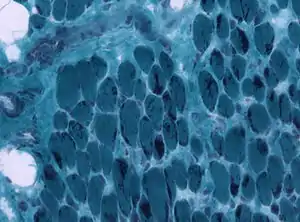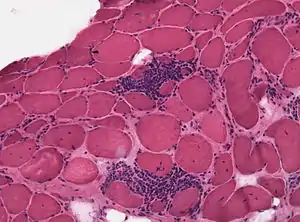Neuromuscular disease
A neuromuscular disease is any disease affecting the peripheral nervous system (PNS),[lower-alpha 1] the neuromuscular junction, or skeletal muscle, all of which are components of the motor unit.[4] Damage to any of these structures can cause muscle atrophy and weakness. Issues with sensation can also occur.
| Neuromuscular disease | |
|---|---|
 | |
| Congenital nemaline myopathy (neuromuscular disorder) | |
| Specialty | Neurology, neuromuscular medicine, physical medicine and rehabilitation |
| Causes | Autoimmune disorders,[1] genetic disorders,[2] environmental factors[3] |
| Diagnostic method | Muscle electrophysiology tests, genetic testing |
| Treatment | Depends on the disorder; many currently have no cure[2] |
Neuromuscular diseases can be acquired or genetic. Mutations of more than 500 genes have shown to be causes of neuromuscular diseases.[5] Other causes include nerve or muscle degeneration, autoimmunity, toxins, medications, malnutrition, metabolic derangements, hormone imbalances, infection, nerve compression/entrapment, comprised blood supply, and trauma.[6]
Signs and symptoms
Symptoms of neuromuscular disease may include numbness, paresthesia, muscle weakness, muscle atrophy, myalgia (muscle pain), and fasciculations (muscle twitches).[2][7]
Causes
Neuromuscular disease can be caused by autoimmune disorders,[1] genetic/hereditary disorders[2] and some forms of the collagen disorder Ehlers–Danlos syndrome,[8] exposure to environmental chemicals and poisoning which includes heavy metal poisoning.[3] The failure of the electrical insulation surrounding nerves, the myelin, is seen in certain deficiency diseases, such as the failure of the body's system for absorbing vitamin B-12.[3]
Diseases of the motor end plate include myasthenia gravis, a form of muscle weakness due to antibodies against acetylcholine receptor,[9][10] and its related condition Lambert–Eaton myasthenic syndrome (LEMS).[11] Tetanus and botulism are bacterial infections in which bacterial toxins cause increased or decreased muscle tone, respectively.[12] Muscular dystrophies, including Duchenne's and Becker's, are a large group of diseases, many of them hereditary or resulting from genetic mutations, where the muscle integrity is disrupted, they lead to progressive loss of strength and decreased life span.[13]
Further causes of neuromuscular diseases are:

Inflammatory muscle disorders
- Polymyalgia rheumatica (or "muscle rheumatism") is an inflammatory condition that mainly occurs in the elderly; it is associated with giant-cell arteritis (It often responds to prednisolone).[14]
- Polymyositis is an autoimmune condition in which the muscle is affected.[15]
- Rhabdomyolysis is the breakdown of muscular tissue due to any cause.[16]
Tumors
- Smooth muscle: leiomyoma (benign)[17]
- Striated muscle: rhabdomyoma (benign)[18]
Diagnosis

Diagnostic procedures that may reveal muscular disorders include direct clinical observations. This usually starts with the observation of bulk, possible atrophy or loss of muscle tone. Neuromuscular disease can also be diagnosed by various blood tests and using electrodiagnostic medicine tests[19] including electromyography[20] (measuring electrical activity in muscles) and nerve conduction studies.[21] Genetic testing is an important part of diagnosing inherited neuromuscular conditions.[19]
Prognosis
Prognosis and management vary by disease.
Notes
- Lower motor neurons originate in the anterior horn of the spinal cord, a part of the central nervous system. However, the anterior horn is also part of the motor unit. Diseases that affect the anterior horn are classified as neuromuscular.
References
- Kraker, Jessica; a. Zivkovic, Sasa (2011). "Autoimmune Neuromuscular Disorders". Current Neuropharmacology. 9 (3): 400–8. doi:10.2174/157015911796558000. PMC 3151594. PMID 22379454.
- "Neuromuscular Disorders: MedlinePlus". www.nlm.nih.gov. Retrieved 2016-04-24.
- Swash, Michael; Schwartz, Martin S. (2013-03-14). Neuromuscular Diseases: A Practical Approach to Diagnosis and Management. Springer Science & Business Media. p. 86,196. ISBN 9781447138341.
- Katirji, Bashar (2014). "Clinical Assessment in Neuromuscular Disorders". In Katirji, Bashar; Kaminski, Henry J.; Ruff, Robert L. (eds.). Neuromuscular disorders in clinical practice (Second ed.). New York. ISBN 978-1-4614-6567-6.
- Dowling, JJ; Weihl, CC; Spencer, MJ (November 2021). "Molecular and cellular basis of genetically inherited skeletal muscle disorders". Nature Reviews. Molecular Cell Biology. 22 (11): 713–732. doi:10.1038/s41580-021-00389-z. PMID 34257452. S2CID 235822532.
- Katirji, Bashar; Kaminski, Henry J.; Ruff, Robert L., eds. (2014). Neuromuscular disorders in clinical practice (Second ed.). New York. ISBN 978-1-4614-6567-6.
- "Myopathy Information Page: National Institute of Neurological Disorders and Stroke (NINDS)". www.ninds.nih.gov. Archived from the original on 2016-04-27. Retrieved 2016-04-24.
- Voermans, Nicol C; Van Alfen, Nens; Pillen, Sigrid; Lammens, Martin; Schalkwijk, Joost; Zwarts, Machiel J; Van Rooij, Iris A; Hamel, Ben C. J; Van Engelen, Baziel G (2009). "Neuromuscular involvement in various types of Ehlers-Danlos syndrome". Annals of Neurology. 65 (6): 687–97. doi:10.1002/ana.21643. PMID 19557868. S2CID 22600065.
- Myasthenia Gravis at eMedicine
- Hill, M (2003). "The Neuromuscular Junction Disorders". Journal of Neurology, Neurosurgery & Psychiatry. 74 (90002): ii32–ii37. doi:10.1136/jnnp.74.suppl_2.ii32. PMC 1765619. PMID 12754327.
- Lambert-Eaton Myasthenic Syndrome (LEMS) at eMedicine
- Kumar, Vinay; Abbas, Abul K.; Aster, Jon C. (2014-09-05). Robbins & Cotran Pathologic Basis of Disease. Elsevier Health Sciences. p. 382. ISBN 9780323296359.
- "Muscular Dystrophy Information Page: National Institute of Neurological Disorders and Stroke (NINDS)". www.ninds.nih.gov. Retrieved 2016-04-24.
- Liaison, Janet Austin, Office of Communications and Public. "Polymyalgia Rheumatica and Giant Cell Arteritis". www.niams.nih.gov. Archived from the original on 2016-05-25. Retrieved 2016-04-24.
- Polymyositis at eMedicine
- MedlinePlus Encyclopedia: Rhabdomyolysis
- Leiomyoma at eMedicine
- Rhabdomyomas at eMedicine
- McDonald, Craig M (2012). "Clinical Approach to the Diagnostic Evaluation of Hereditary and Acquired Neuromuscular Diseases". Physical Medicine and Rehabilitation Clinics of North America. 23 (3): 495–563. doi:10.1016/j.pmr.2012.06.011. PMC 3482409. PMID 22938875.
- Darras, Basil T.; Jones, H. Royden Jr.; Ryan, Monique M.; de Vivo, Darryl C. (2014-12-03). Neuromuscular Disorders of Infancy, Childhood, and Adolescence: A Clinician's Approach. Elsevier. p. 488. ISBN 978-0124171275.
- Electromyography and Nerve Conduction Studies at eMedicine
Further reading
- Wokke, John H. J.; Doorn, Pieter A. van; Hoogendijk, Jessica E.; Visser, Marianne de (2013-03-07). Neuromuscular Disease: A Case-Based Approach. Cambridge University Press. ISBN 9781107328044.
- Ambrosino, N; Carpene, N; Gherardi, M (2009). "Chronic respiratory care for neuromuscular diseases in adults". European Respiratory Journal. 34 (2): 444–451. doi:10.1183/09031936.00182208. PMID 19648521.